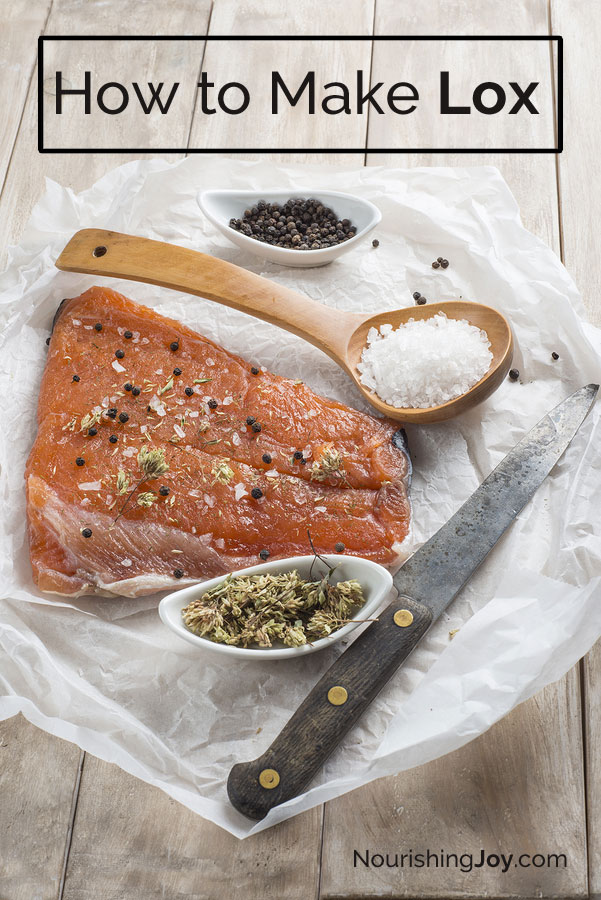How to Make Lox
This post may contain affiliate links, including those from Amazon.com, which means we earn a small commission off your purchases. And here's the thing: We only mention services and products that we think are truly worth your attention, whether they're free, paid, or otherwise. This site relies on YOUR trust, so if we don't stand behind a product 110%, it's not mentioned. Period.
As an opera singer, there was a period of time when I was in and out of New York City regularly. Everything for an up-and-coming singer seems to be centered there, so naturally, I was too.
One of things I looked forward to most on my regular pilgrimages were the lox and bagels – with the proper schmear of cream cheese, of course. The ubiquitous Jewish delis near most of the places I lived lured me every morning to indulge my craving for yeasty, salty goodness.
Now, at a different time of life, I haven't been to New York for several years, but I still long for my beloved lox, bagels, and cream cheese. But since I've spent the last few years devouring information about traditional methods of food preparation and putting them to practice in my own kitchen, I've realized it's really quite a cinch to make traditional lox at home, provided you have access to fresh salmon.
(Granted, the first time I made this, I thought it needed to sit at room temperature like all the other cultured and fermented foods I'd made up to that point – but hey, you live you learn!)
Want to make homemade bagels too? Check out our New York deli-inspired recipe!
Lox
Ingredients
- 1 cup coarse, unrefined sea salt
- ½ cup fresh dill, 2-3 large fronds, torn
- 2-3 tablespoons black peppercorns and/or dried juniper berries
- 2 filets of wild salmon, skin-on
Instructions
- Mix the salt and the spices together in a bowl until evenly mixed.
- Place a long strip of plastic wrap on a baking sheet just long enough to accommodate the salmon. (See where to buy PVC, BPA, and plasticizer free plastic wrap.)
- Place one filet of salmon face-up on the plastic wrap. Pour half of the salt mixture over the filet, then lay the other filet face-down on top of the first.
- Pour the rest of the salt mixture over the filets and pull the plastic wrap up and over the salmon as tightly as you can. If the filets are small enough, place the wrapped filets in a resealable plastic bag. Otherwise, place the fish in a baking pan or baking sheet long enough to accommodate the entire salmon. You don't want the fish to lose any of its brine!
- Place the salmon in the refrigerator and weight it with a plate or a brick on top of it. Cure the salmon for 3 days, turning the salmon stack over once a day.
- To serve, brush off the salt and spices and slice thinly or dice, according to use.










Trying this now…let you know in 3 days how it is!!
Is dill the only herb recommended, or are there any others that would suit this preparation?
Use any herb you like! Dill is the classic herb used in this application, but certainly, any herb or spice flavor you like with salmon can be used.
Enjoy!
Thanks for the recipe, Kresha. How long does this keep once its cured?
It should keep for 1-2 weeks in the refrigerator and for several months in the freezer if it’s wrapped well. If you choose to freeze it, you can either freeze the whole filet or slice it or dice it first. It freezes well either way and it just depends on what you want to do with it once it’s thawed.
Enjoy!
Oh my gosh, I am so glad I stumbled onto this recipe (linked from 101 fermented foods and GNOWFLGINS)! I fell in love with lox when I was travelling in Norway many years ago and I’ve had idea how to create it myself. Thanks for the recipe!
So basically all you do is salt and pepper the salmon (I hate dill) and wrap it tight. Put a weight on it and refrigerate it for 3 days flipping it daily?
I have to try this. I love lox.
Thank you for the recipe!
Yup! That’s it! Enjoy. 🙂
Hello,
I was wondering if I wanted lox for Christmas can I make it now. If so how would I store it until then. Also can I keep it in the brine until then…what would that do.
Thanks a bunch.
I have a huge piece of salmon all ready to go.
Shireen
Shiren, I would do the brine just for the three days (maaaaybe four), then decide how you want to store it until you use it. The lox should stay fresh for 1-2 weeks in the refrigerator out of the brine and for several months in the freezer if it’s wrapped well. If you choose to freeze it, you can either freeze the whole filet or slice it first – totally up to you.
I hope that helps! 🙂
I am so excited about this wonderful recipe. Every Christmas we have bagels and lox for brunch. You have just saved me tons of money I am sure of it. Every year I buy those dumb little packets of lox for a ton of money. I usually buy several as I have 7 kids 6 of which are sons and they all love it. We live in the north so we don’t have ready access to fresh lox unfortunately. Love, love, love this. Thanks!
Shireen –
Do you have a Sam’s Club or Costco near you? They both carry lox at much more reasonable prices than those little packages.
Nope! Sams is about 2 1/2 hours a way. But thank you.
How big is the filet of salmon this recipe is intended for? I used to portions of salmon from costco. If I want to do more than that do I need more of the salt or is that amount still ok?
The size isn’t terribly important as long as they fit on a baking sheet. If they’re larger than that, then you’ll need to cut them to fit, as yes, the amount of salt can be used with any amount of fish that fits on a baking sheet – if it’s larger than that, then you’ll need more salt. And too much salt is better than too little salt, which is why even if you have small filets, I recommend still using the same amount of salt.
Also, if you’re wanting to make more, I would recommend doing a double batch – double all the ingredients (even that means just cutting two very large filets into two pieces each to make a total of four pieces) and wrap them as two separate bundles.
I hope that helps!